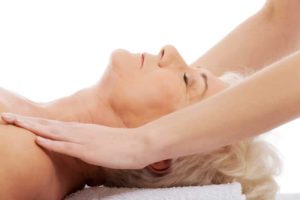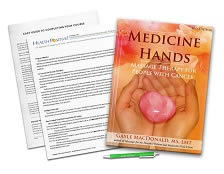

Just as for the general population, there are many benefits of massage for breast cancer patients and breast cancer survivors. Despite lingering fears among some segments of the population that massage might be harmful for those with cancer, “there is no evidence that massage can encourage breast cancer cells to spread around the body,” and massage is safe even if someone is undergoing chemotherapy (1).
- With that concern put to rest, just what are the benefits of massage for those who have or had breast cancer?
- What are the contraindications?
- And what types of massage are most beneficial for work with cancer patients and survivors?
7 Benefits of Massage for Patients with Breast Cancer
- Nausea reduction in chemotherapy recipients. Nausea is a major and common side effect of chemotherapy, but a study out of Sweden showed a significant reduction in that effect for women who had received 20-minute massages on five different occasions (2).
- Decreased anxiety. While anxiety can be beneficial in the short term, allowing you to respond properly to an intense situation, anxiety that persists for a prolonged period of time can weaken the immune system (3). Anxiety reduction, therefore, can be an important factor in recovering from cancer. Various kinds of massage have all proven to be effective in lowering anxiety levels among breast cancer patients (4, 5, 6, 7).
- Improved mood. Depression is common among breast cancer patients, with estimates of occurrence ranging from almost 25% (8) to as high as 46% (9), and those suffering this symptom reporting a negative impact on their quality of life (8). Massage, however, has been found to be effective in combatting depression in breast cancer patients (7, 10, 11).
- Reduced fatigue. Fatigue, which many breast cancer patients experience after chemotherapy treatments (12), has also been shown to improve with massage (11, 13, 14).
- Better immune function. A particularly valuable benefit of massage therapy for breast cancer patients and survivors is that it has been shown to increase both natural killer cells and lymphocytes, which are white cells crucial to the immune system (7). Natural killer cells, which are also part of our innate immune systems, “control several types of tumors and microbial infections by limiting their spread and subsequent tissue damage” (15).
- Pain relief. Pain is a symptom present not only immediately following surgery but can be a chronic issue for breast cancer survivors. Nerve and tissue damage can result from the cancer as well as from the treatments for it (16). Fortunately, massage therapy can provide relief from a range of pain associated with breast cancer (5, 6, 11, 17).
- Relaxation. Relaxation may seem like an almost superficial benefit, compared with more urgent concerns like pain, nausea, and immune function, but “after a breast cancer diagnosis, feeling stressed and being less active than usual can contribute to muscle tension and discomfort” (1). In addition, stress is known to slow wound healing (18). Research suggests that “interventions to reduce the patient’s psychological stress level may improve wound repair and recovery following surgery” (19). Massage, of course, is well-established as a stress-relieving therapy.
6 Massage Contraindications for Patients with Breast Cancer
- When redness from radiation is still present. Radiation can cause skin damage, ranging from dryness and itching to blistering and peeling (20), making the affected skin very sensitive. Using massage oils and massaging skin that is already irritated can make the skin feel even worse (21). This is a local contraindication.
- No deep tissue during chemo or radiation. Chemotherapy can cause a decrease in both white and red blood cells, which increases the potential for bruising (21). In addition, deep tissue can overburden a system that is already weakened from chemotherapy and radiation (21).
- Areas of lymphedema. Traditional massage done on areas of lymphedema can exacerbate the condition (21, 22), making such areas locally contraindicated for those without special training (see below, under “Best types of massage”).
- Incision sites. Incision sites are locally and regionally contraindicated because of concerns about thrombosis and because the site is involved in a complex healing process (22), which could be disrupted if tissue in the area is manipulated. An incision site that is not completely healed is also more prone to becoming infected (22, 23).
- When nausea is present. Techniques that involve jostling, rocking, stretching, and range of motion are contraindicated as they can create proprioceptive challenges for the client (22).
- If peripheral neuropathy has developed. Manifesting as tingling, burning, numbness, or pain in the hands or feet, peripheral neuropathy can be a side effect of chemotherapy. The use of pressure should be avoided for these areas, though broad and gentle whole-hand contact sometimes helps relieve the pain (22).
Best Types of Massage for Patients with Breast Cancer

Swedish massage, because of its relaxing nature, can be especially helpful with relieving anxiety, stress, and depression. It is also helpful for restoring range of motion and reducing scar tissue, once the incision site is sufficiently healed (24).
Manual lymph drainage is designed to reduce the swelling that is characteristic of lymphedema and is a side effect of having cancerous lymph nodes removed during a mastectomy (25). In addition, “the light, supportive touch of a lymphatic drainage massage therapist will help breast cancer survivors deal with anxiety, pain and difficulty of adjusting to life after treatment” (25).
With its focus on restoring energy, shiatsu can help support a client’s immune system and fight fatigue during treatment for breast cancer (24).
A common side effect of radiation therapy is fibrosis (excessive fibrous connective tissue) in and around the areas targeted by the radiation, including muscles, fascia, organs and bones. For breast cancer patients, this can include the armpit, neck, shoulder, and thoracic muscles and ribs. Deep friction techniques have been shown to be effective in breaking down fibrotic tissues, relieving the pain and spasms that this radiation-induced fibrosis can cause (26).
Eeris Kallil, a 2014 inductee into the Massage Hall of Fame, created a Shiatsu-based massage called IntuAtsu to help clients in their recovery from breast massage. Using a “combination of meridian work, massage, and mind relaxation techniques,” IntuAtsu brings “balance, harmonious flow and integration to all three aspects, and aid[s] with releasing stresses of dealing with illness and treatment” (24).
Cross-friction massage may be effective in altering the tissue of a scar—specifically, reducing its height, itchiness, and pain, among other beneficial changes (27, 28). Though the evidence for the efficacy of remodeling scar tissue using massage is preliminary at this juncture, it does show promise.
Myofascial release is frequently used to address the adhesions that accompany scar tissue. The manipulation of the underlying tissues around the scar can help release the adhesions, improving movement in the restricted areas (28).
Reflexology has proved useful in reducing pain and anxiety in breast cancer patients (4, 6).













